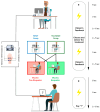Placebos in Healthcare: A Behavioral Study on How Treatment Responsiveness Affects Therapy Decisions in a Simulated Patient-Physician Interaction
- PMID: 39451885
- PMCID: PMC11506822
- DOI: 10.3390/clinpract14050170
Placebos in Healthcare: A Behavioral Study on How Treatment Responsiveness Affects Therapy Decisions in a Simulated Patient-Physician Interaction
Abstract
Background and purpose: Treatment choice during clinical practice is crucial to best help each patient. One of the physicians' main goals is choosing a personalized effective treatment, but it also represents a challenging issue. Here, we explored different treatment choices in a simulated patient-physician interaction.
Materials and methods: Medical students (n = 48) and young Practicing Physicians (n = 20) were recruited to behave as "physicians" while fellow researchers acted as "patients". Participants were divided equally into a Belief Group, which received positive information about placebo efficacy, and a Non-Belief Group, which received negative information. Empathy traits and psychological variables were measured in both groups. During the task, participants were asked to choose between an active (TENS treatment) or a placebo treatment, to reduce patients' pain. Patients never underwent the painful stimulation but acted as if they had, simulating high or low pain responses to the placebo treatment (placebo-responders/placebo non-responders) and low pain to the TENS treatment.
Results: Behavioral results showed that the Belief Group gave significantly more placebo treatments when faced with a patient that simulated placebo responsiveness, while the Non-Belief group showed a mirrorlike behavior, administrating more believed TENS treatments when faced with a placebo non-responder. No differences were found between Medical Students and Practicing Physicians.
Conclusions: This study constitutes a frame of reference for medical treatment decisions, indicating that physicians' treatment choices are influenced by patients' responsiveness to the treatments, as well as by their prior beliefs and empathy traits.
Keywords: empathy; general practice; physician–patient relationship; placebo effect; placebos; treatment outcome.
Conflict of interest statement
The authors declare no conflicts of interest.
Figures




Similar articles
-
Placebo prescription and empathy of the physician: A cross-sectional study.Eur J Gen Pract. 2017 Dec;23(1):98-104. doi: 10.1080/13814788.2017.1291625. Eur J Gen Pract. 2017. PMID: 28347193 Free PMC article.
-
Patient attitudes about the clinical use of placebo: qualitative perspectives from a telephone survey.BMJ Open. 2016 Apr 4;6(4):e011012. doi: 10.1136/bmjopen-2015-011012. BMJ Open. 2016. PMID: 27044586 Free PMC article.
-
Observing physicians acting with different levels of empathy modulates later assessed pain tolerance.Br J Health Psychol. 2022 May;27(2):434-448. doi: 10.1111/bjhp.12553. Epub 2021 Aug 10. Br J Health Psychol. 2022. PMID: 34374180
-
Complementary and alternative therapies for post-caesarean pain.Cochrane Database Syst Rev. 2020 Sep 1;9(9):CD011216. doi: 10.1002/14651858.CD011216.pub2. Cochrane Database Syst Rev. 2020. PMID: 32871021 Free PMC article.
-
Relief of pain due to uterine cramping/involution after birth.Cochrane Database Syst Rev. 2020 Oct 20;10(10):CD004908. doi: 10.1002/14651858.CD004908.pub3. Cochrane Database Syst Rev. 2020. PMID: 33078388 Free PMC article.
Cited by
-
Contextual effects in musculoskeletal pain: are we overlooking essential factors?Front Psychol. 2025 Feb 17;16:1537242. doi: 10.3389/fpsyg.2025.1537242. eCollection 2025. Front Psychol. 2025. PMID: 40034938 Free PMC article. No abstract available.
References
Grants and funding
LinkOut - more resources
Full Text Sources

